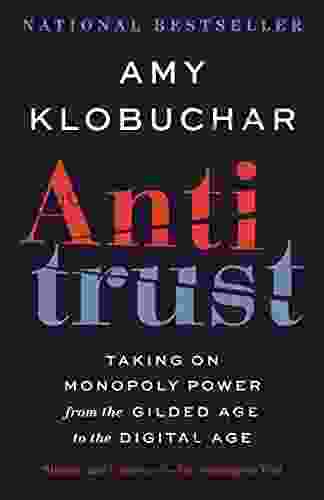Taking On Monopoly Power: A Historical Struggle From the Gilded Age to the Digital Age

Monopoly power has been a recurring problem in the American economy since the late 19th century. Gilded Age industrialists like John D. Rockefeller and Andrew Carnegie used their vast wealth to control entire industries, driving up prices and stifling competition. In response, the Sherman Antitrust Act was passed in 1890, but it proved to be largely ineffective in curbing the power of trusts.
4.6 out of 5
| Language | : | English |
| File size | : | 85947 KB |
| Text-to-Speech | : | Enabled |
| Screen Reader | : | Supported |
| Enhanced typesetting | : | Enabled |
| Word Wise | : | Enabled |
| Print length | : | 797 pages |
| X-Ray | : | Enabled |
| Hardcover | : | 224 pages |
| Item Weight | : | 12.8 ounces |
| Dimensions | : | 6.14 x 0.51 x 9.21 inches |
| Paperback | : | 224 pages |
The 20th century saw a renewed push for antitrust enforcement, led by Presidents Teddy Roosevelt, Woodrow Wilson, and Franklin D. Roosevelt. The Clayton Act of 1914 and the Federal Trade Commission Act of 1914 gave the government new tools to break up monopolies and prevent unfair business practices.
In recent decades, monopoly power has once again become a major problem, as a handful of large companies have come to dominate the digital economy. Companies like Microsoft, Facebook, Google, and Our Book Library have used their size and market power to stifle competition, raise prices, and collect vast amounts of personal data.
In this book, Lina Khan tells the story of the fight against monopoly power in America, from the Gilded Age to the Digital Age. She explores the legal, political, and economic battles that have shaped the American economy and society.
Chapter 1: The Gilded Age
The late 19th century was a time of great economic growth and industrialization in the United States. However, this growth also led to the rise of monopolies, as a few large companies came to dominate entire industries.
One of the most famous examples of a Gilded Age monopoly was Standard Oil, founded by John D. Rockefeller. Standard Oil controlled over 90% of the oil refining industry in the United States, and it used its power to drive up prices and stifle competition.
Other Gilded Age monopolies included Carnegie Steel, American Tobacco, and Western Union. These companies used their vast wealth and market power to crush their rivals, and they often engaged in anti-competitive practices such as price fixing and predatory pricing.
Chapter 2: The Progressive Era
The Progressive Era was a time of great social and political reform in the United States. Progressives were concerned about the growing power of monopolies, and they believed that the government should take action to break them up.
In 1890, the Sherman Antitrust Act was passed, which outlawed monopolies and other anti-competitive practices. However, the Sherman Act proved to be largely ineffective in curbing the power of trusts.
In 1914, the Clayton Act and the Federal Trade Commission Act were passed. These laws gave the government new tools to break up monopolies and prevent unfair business practices.
Chapter 3: The New Deal
The Great Depression was a time of economic crisis in the United States. In response to the Depression, President Franklin D. Roosevelt launched the New Deal, a series of economic recovery programs.
One of the goals of the New Deal was to break up monopolies and promote competition. Roosevelt appointed Thurman Arnold as the head of the Antitrust Division of the Department of Justice, and Arnold launched a vigorous campaign against corporate power.
Arnold broke up several large monopolies, including Standard Oil and American Tobacco. He also prosecuted companies for anti-competitive practices such as price fixing and predatory pricing.
Chapter 4: The Post-War Era
After World War II, the United States entered a period of economic growth and prosperity. However, monopoly power continued to be a problem, as a few large companies came to dominate the economy.
In the 1960s and 1970s, the government launched a new wave of antitrust enforcement. The government broke up several large companies, including AT&T and IBM. The government also passed new laws to strengthen antitrust enforcement.
Chapter 5: The Digital Age
In recent decades, monopoly power has once again become a major problem, as a handful of large companies have come to dominate the digital economy.
Companies like Microsoft, Facebook, Google, and Our Book Library have used their size and market power to stifle competition, raise prices, and collect vast amounts of personal data.
The government has taken some steps to address the problem of monopoly power in the digital economy. In 2020, the Department of Justice filed an antitrust lawsuit against Google, alleging that the company had abused its monopoly power in search and advertising. The government has also launched antitrust investigations into Our Book Library, Facebook, and Apple.
The fight against monopoly power has been a recurring theme in American history. In the Gilded Age, the Progressive Era, the New Deal, the Post-War Era, and the Digital Age, government officials and reformers have fought to break up monopolies and promote competition.
The fight against monopoly power is not over. Today, a handful of large companies have come to dominate the digital economy, and they are using their size and market power to stifle competition, raise prices, and collect vast amounts of personal data.
Government action is needed to break up monopolies and promote competition in the digital economy. This will require a new generation of antitrust enforcers who are willing to stand up to corporate power and protect the interests of consumers.
4.6 out of 5
| Language | : | English |
| File size | : | 85947 KB |
| Text-to-Speech | : | Enabled |
| Screen Reader | : | Supported |
| Enhanced typesetting | : | Enabled |
| Word Wise | : | Enabled |
| Print length | : | 797 pages |
| X-Ray | : | Enabled |
| Hardcover | : | 224 pages |
| Item Weight | : | 12.8 ounces |
| Dimensions | : | 6.14 x 0.51 x 9.21 inches |
| Paperback | : | 224 pages |
Do you want to contribute by writing guest posts on this blog?
Please contact us and send us a resume of previous articles that you have written.
 Book
Book Novel
Novel Page
Page Chapter
Chapter Text
Text Story
Story Genre
Genre Reader
Reader Library
Library Paperback
Paperback E-book
E-book Magazine
Magazine Newspaper
Newspaper Paragraph
Paragraph Sentence
Sentence Bookmark
Bookmark Shelf
Shelf Glossary
Glossary Bibliography
Bibliography Foreword
Foreword Preface
Preface Synopsis
Synopsis Annotation
Annotation Footnote
Footnote Manuscript
Manuscript Scroll
Scroll Codex
Codex Tome
Tome Bestseller
Bestseller Classics
Classics Library card
Library card Narrative
Narrative Biography
Biography Autobiography
Autobiography Memoir
Memoir Reference
Reference Encyclopedia
Encyclopedia Amy Pflueger
Amy Pflueger Tessy Braun
Tessy Braun Susan Gast
Susan Gast Kenneth W Noe
Kenneth W Noe Sidney Bristol
Sidney Bristol Antonio Machado
Antonio Machado D W Curtis
D W Curtis Frederic Tuten
Frederic Tuten Anna Myers
Anna Myers Amy B Zegart
Amy B Zegart Bryce Beattie
Bryce Beattie Mary Ellen Snodgrass
Mary Ellen Snodgrass Erika Schelby
Erika Schelby Greg Prato
Greg Prato Aman Khan
Aman Khan Amanda Skou
Amanda Skou Shanda Trofe
Shanda Trofe Jennifer Jones
Jennifer Jones Amy Chally
Amy Chally Steve Saroff
Steve Saroff
Light bulbAdvertise smarter! Our strategic ad space ensures maximum exposure. Reserve your spot today!
 Richard AdamsFollow ·8.4k
Richard AdamsFollow ·8.4k Aleksandr PushkinFollow ·18.6k
Aleksandr PushkinFollow ·18.6k Devin CoxFollow ·7.9k
Devin CoxFollow ·7.9k Charles ReedFollow ·18.9k
Charles ReedFollow ·18.9k Leon FosterFollow ·5.8k
Leon FosterFollow ·5.8k Easton PowellFollow ·2.2k
Easton PowellFollow ·2.2k Lord ByronFollow ·10.2k
Lord ByronFollow ·10.2k Enrique BlairFollow ·9.5k
Enrique BlairFollow ·9.5k

 Roald Dahl
Roald DahlImmerse Yourself in a Mesmerizing Tapestry of Creativity:...
Prepare to be captivated by "Spectra," an...

 Clarence Brooks
Clarence BrooksUnleash Your Inner Taylor with Red Piano Vocal Guitar:...
Embrace the Red Era...

 Jeffrey Hayes
Jeffrey HayesUnlock Your Child's Academic Potential: A Comprehensive...
In today's rapidly changing...

 William Golding
William GoldingBrave Elizabeth: A Captivating Tale of Resilience and...
Immerse Yourself in a Riveting Historical...

 Curtis Stewart
Curtis StewartUnveiling the Heartfelt Melodies of Taylor Swift: A...
Step into the enchanting world of Taylor...
4.6 out of 5
| Language | : | English |
| File size | : | 85947 KB |
| Text-to-Speech | : | Enabled |
| Screen Reader | : | Supported |
| Enhanced typesetting | : | Enabled |
| Word Wise | : | Enabled |
| Print length | : | 797 pages |
| X-Ray | : | Enabled |
| Hardcover | : | 224 pages |
| Item Weight | : | 12.8 ounces |
| Dimensions | : | 6.14 x 0.51 x 9.21 inches |
| Paperback | : | 224 pages |














